#smacs0723
Text
James Webb Uzay Teleskobundan İlk Görüntüler

James Webb Uzay Teleskobundan İlk Görüntüler Geldi
Geçtiğimiz aylarda James Webb Uzay Teleskobunun ne olduğundan ve amacından bahsetmiş, Haziran ayında bize göndereceği görüntüleri görmek içinde sabırsız bir bekleyişte olduğumuzu daha doğrusu tüm dünyadaki insanların sabırsız bir bekleyişte olduğunu söylemiştik. Geçtiğimiz günlerde ise Uzay Teleskobu yörüngesine oturtuldu ve gerekli ayarlamalar yapılarak James Webb Uzay Teleskobundan ilk görüntüler dünyamıza geldi.
Her fotoğrafı ayrı ayrı inceleyecek ve bu görüntülerdeki detayları sizinle paylaşacağız. Ama önce kısa ve hatırlatıcı olarak bir kez daha bu teleskobun ayrıntılarından bahsetmekte fayda var.
2007 yılında projenin bitirilmesi beklenirken teleskop, 25 Aralık 2021 tarihinde uzaya fırlatılarak dünyamızdan oldukça uzakta L2 yörüngesine doğru yolculuğa çıktı. Projenin bu kadar uzamasının nedeni ilk defa bu denli büyük bir projenin uzaya fırlatılacak olması. +10 milyar dolardan fazla miktardaki mali kaynağın ayrılması projenin herhangi bir aksaklıkta veya bir meteor çarpmasında bozulmasını önlemek amacıyla tekrar tekrar denemeler yapılarak teleskobun çalışamaz hale gelmesinin önüne geçmekti.
James Webb Uzay Teleskobu hakkında daha detaylı bilgi almak için tıklayınız.
Şansa bakın ki yörüngesine oturur oturmaz bir meteor James Webb Uzay Teleskobuna çarptı bile. Fakat 25 yıllık çalışmayla birlikte zaten böyle bir şeyin olma olasılığı hesaplanmış ve buna karşı ciddi ve pek çok önlem alınmıştı. Teleskop bu çarpmadan hiçbir hasar almadan işlevine devam etti.
Webb Uzay Teleskobunun Yörüngesi
Yörüngesinden bahsedecek olursak dünyadan oldukça uzakta 1 milyon 500 bin kilometre ötedeki L2 yörüngesi seçildi. Bunun temelde 2 nedeni var, Güneşten ve Dünyamızdan gelen ışığın James Webb Uzay Teleskobunun yakalayacağı görüntülere zarar vermemesinin istenmesi.
Bir diğer nedeni ise L2 yörüngesinin diğer yörüngelere nazaran daha az meteor ve asteroid içermesi. Oldukça farklı bir yörünge izleyen James Webb Uzay Teleskobu hem dikeyde dairseler olarak bir yörünge izliyor hem de L2 yörüngesinde ilerliyor. Görselde bunu daha net olarak görebilirsiniz.

James Webb Uzay Teleskobunun Yörüngesi
6 aylık bir ön hazırlık sürecinin ardından bilim adamlarınca belirlenen 5 ayrı noktaya odaklanan James Webb Uzay Teleskobu 5 ayrı görüntüyü dünyamıza gönderdi. Görüntüler NASA’nın 12 Temmuz tarihinde yaptığı canlı yayın ile tüm dünyaya gösterildi.
Bu 5 ayrı nokta 10 yılı aşkındır bilim adamlarınca yapılan önermeler ile belirlendi. Her bilim adamı evrenin gözlemek istediği noktasını ve önemini detaylı olarak NASA’ya iletti ve bu noktalar önem sırasına göre kabul edildi. 70 ayrı görevi hazır olan James Webb Uzay Teleskobu ilk 5 görevini oldukça başarılı bir şekilde tamamladı.
Görüntülere geçmeden önce James Webb Uzay Teleskobundan önce görev yapmakta olan, hala işlevini yitirmemiş Hubble Uzay Teleskobu hakkında detaylı bilgi almak için tıklayınız.
SMACS 0723
İlk görüntü 11 Temmuz günü, Başkan Joe Biden ile yapılan bir toplantı sırasına gösterildi.
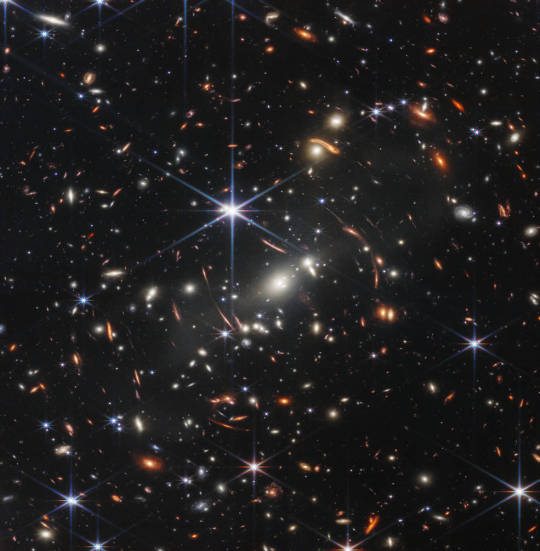
SMACS 0723'nin Webb Tarafından Çekilen Görüntüsü
Genç evrenin bugüne kadarki en detaylı görüntüsü SMACS 0723 adlı galaksi kümesine bakılarak görüntülendi. Kızılötesi teknolojisi sayesinde çekilen bu fotoğraf evrenin erken evresine dair pek çok detayı içeriyor. Bu galaksilerden gelen ışığın bize ulaşması neredeyse milyarlarca yıl sürdü.
Dünyamızdan 4.6 milyar ışık yılı uzaklıktaki SMACS 0723 adlı bu galaksi kümesinde oldukça parlak görünen cisimler yıldız, toplu ve daha sönük olanlar ise galaksileri temsil ediyor. Kırmızı renkteki galaksiler ise daha eski galaksilerdir, kırmızı görünmesinin sebebini herkes duymuştur “red shift” yani kırmızıya kayma. Bir galaksi bizden ne kadar uzaktaysa o kadar kırmızı renge kayar ve gözle görülemez bir hale gelir. Bu yüzden kızılötesi teknolojisini kullanarak bunları görebiliyoruz. Bu görseldeki bize en uzak galaksi ise 13.1 milyar ışık yılı uzaklıkta.

Webb Tarafından Çekilen Erken Evrenin Görüntüsü(SMACS 0723)
James Webb Uzay Teleskobunun amacından ve ne işe yaradığından bahsederken sıkça evrenin ilk safhalarını görmemize olanak sağlayacak olmasından bahsetmiştik. Bu fotoğraf bunun için çok büyük bir umut ışığı yakıyor. Genç evreni gözlemleyebiliyor ve görebiliyoruz.
13.1 MİLYON IŞIK YILI UZAKLIKTA GALAKSİYİ GÖREBİLİYORUZ.
Görüntüde görebileceğiniz bir diğer detay ise bazı kırmızı galaksilerin sanki sündürülmüş bir taraflarından tutup uzatılmış gibi görünmesi. Bunun nedeni ise bu galaksilerin eski ve yaşlı olmasından ve onların önündeki daha genç galaksilerin, eski galaksilerin ışığının bize gelirken kütle çekim kuvveti yüzünden kırılması ve bozulmasıdır. Yani görüntüde herhangi fiziki bir oynama yok.
James Webb Uzay Teleskobu bu görüntüyü çekebilmek için tam tamına 12 saat odaklanması gerekti. Hubble Uzay Teleskobun ise bu görüntüyü yakalayabilmesi için neredeyse 2 haftalık bir zaman dilimi gerekiyor.
Aşağıdaki fotoğrafta Hubble ve James Webb Uzay teleskobu tarafından çekilen SMACS 0723 galaksi kümesinin fotoğrafını görebilirsiniz. Aradaki farkı anlamak güç değil.

Sol taraftaki Hubble / Sağ taraftaki Webb Uzay Teleskobu(SMACS 0723)
Carina Nebulası

Webb Teleskobu Tarafından Çekilen Carina Nebulası
Bir sonraki görevi ise Carina Nebulası veya Carina Bulutsusu. Bu görüntü pek çok bilim insanının gözyaşlarını tutamamasına neden olmuş. Görmekte olduğunuz bir görüntü uzayın doğumevi olarak da geçiyor. 5 görsel arasındaki en heyecan verici ve en detaylı veriler kuşkusuz bu görselde barınmakta.
Üst tarafta yeni doğmuş bebek ve genç yıldızları görüyoruz. Bunlar daha çok genç ve çok sıcak yeni yeni bir yıldıza dönüştüler. Alt tarafta gaz bulutunun içerisinde doğacak olan diğer yıldızlar gelecek milyar yıllar içerisinde bir yıldıza dönüşecek. Gaz bulutunun içerisinde yıldızı oluşturacak temel elementler giderek etkileşime girecek ve ortaya yeni yıldızlar doğacak.
Aynı görüntüde hem yeni doğmuş yıldız ve galaksileri hem de yeni doğacak olan yıldız ve galaksileri görmek tüyleri ürpertiyor. Belki de yeni doğan galaksilerin içerisinde bir canlı yaşam mevcut veya yeni doğacak henüz doğmamış galaksilerin içerisindeki bir gezegende canlı yaşam mevcut olacak…
Stephan Beşlisi
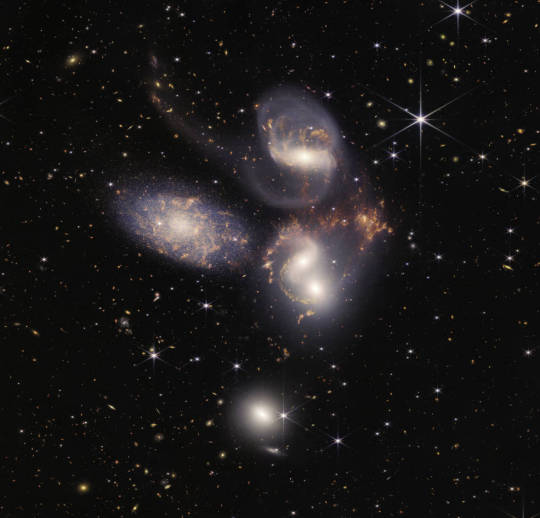
Stephan Beşlisi
Bir diğer görev ise Stephan Beşlisi. Bunu seçmelerinin nedeni burada bulunan galaksilerin birbirlerinin çok yakınında olması hatta 2 galaksinin birbirleri ile çarpışması. Etraftaki gaz ve toz bulutunun görebilmek mümkün bu yeni galaksilerin ve yıldızların doğumuna işaret ediyor.
Fotoğrafı daha önce yine Hubble Tarafından çekildi, ve burada 5 galaksinin bulunduğunu biliyorduk fakat James Webb Uzay Teleskobu bize bundan çok daha fazlasını söylemeyi başardı. Fotoğraftaki gaz ve toz bulutunun kimyasal yapısını da biliyoruz artık.
Aşağıdaki fotoğrafta Hubble ve James Webb Uzay teleskobu tarafından çekilen Stephen Beşlisinin fotoğrafını görebilirsiniz.

Sol taraftaki Hubble / Sağ taraftaki Webb Uzay Teleskobu(Stephen Beşlisi)
Southern Ring Nebulası

Southern Ring Nebulası
Bir diğer görev ise Southern Ring Nebulası yani Güney Halka Bulutsusu. Bu görüntüde oldukça güzel, ölmekte bir yıldızın adeta son nefesini verikenki halini görüyoruz. Yıldız öldüğü yani patladığı zaman etrafa saçtığı partiküllerin oluşturduğu bulutsu dalgayı görebiliyoruz.
Aşağıdaki fotoğrafta Hubble ve James Webb Uzay teleskobu tarafından çekilen Güney Halka Bulutsusunun fotoğrafını görebilirsiniz.
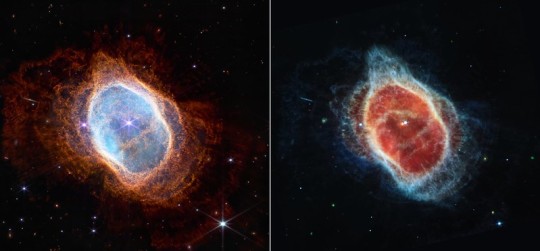
Sol Taraf Webb/ Sağ Taraf Hubble (Southern Ring Nebulası)
Wasp-96 b Öte Gezegeni

Wasp-96 b Öte Gezegeni Veri Grafiği
Son olarak bir öte gezegeni hedef alan James Webb Uzay Teleskobu WASP-96 b gezegenini yakın olarak görüntülemeyi başardı. Aslında görebileceğimiz şey bir görüntü değil bir veri setinin grafiğe işlenmiş hali. Bu gezegen güneşimiz benzeri bir yıldızın etrafında 1 tam turunu yaklaşık 3,5 günde tamamlıyor. Yani bizim 1 yılımız orada 3,5 güne eşit.
Dünyadan yaklaşık 150 bin ışık yılı uzaklıktaki sıcak ve çeşitli gazların çevrelediği bu öte gezegende James Webb Uzay Teleskobu buradaki su moleküllerinin varlığını tespit etti.
Sadece 1 haftalık bir sürede bize bu denli yüksek çözünürlükte görseller sunan James Webb Uzay Teleskobu ve biz dünyalılar için sadece bu bir başlangıç. 10 ila 15 yıllık görev süreci bulunan Teleskop herhangi bir aksilik yaşanmadığı sürece önümüzdeki günlerde bilim adamlarınca seçilen diğer noktalara odaklanarak bize pek çok farklı yerleri gösterebilecek.
Evrenin çok genç olduğu zamanlara +13 milyar ışık yılı uzaklıklardaki galaksileri ve yıldızları gözlemlemek artık mümkün. James Webb Uzay Teleskobu bununla da yetinmeyip gözlemlediği gezegenleri hangi moleküllerden oluştuğuna dair verileri de bize aktarmaya çalışacak.
NASA’nın sloganı ile sözü şimdilik bitirelim öyleyse.
GO WEBB
Kaynak: https://bilimuzay.com/james-webb-uzay-teleskobundan-ilk-goruntuler/
Read the full article
#carinanebulası#jameswebbuzayteleskobu#smacs0723#southernringnebulası#stephenbeşlisi#wasp-96b#webbuzayteleskobu
0 notes
Text
NASA's Webb Telescope Has Discovered the Profoundest Infrared Image Of The Early Universe
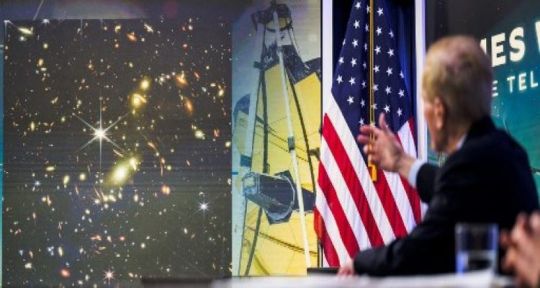
NASA announced Monday that the James Webb Space Telescope, the most powerful observatory ever placed in orbit, has revealed the "deepest and clearest infrared image of the early universe" ever taken, dating back 13 billion years. The stunning image, revealed by President Joe Biden in a White House briefing, is teeming with thousands of galaxies and features the faintest items ever observed, colorized from infrared to blue, orange, and white tones. "This telescope is one of the great engineering achievements of humanity," he said.
Webb's First Deep Field depicts SMACS 0723, a galaxy cluster that acts as a gravitational lens, magnifying even more distant galaxies behind it.
These faint background galaxies have been brought into sharp focus by Webb's primary imager NIRCam, which operates in the near infrared spectral region because light from the expansion of the universe has been stretched out by the time it reaches us.
Webb completed the fibreglass shot in 12.5 hours, outperforming the Hubble Space Telescope by weeks.
The next batch of pictures will be available on Tuesday.
Initial goals
An international committee decided that the Carina Nebula, a massive cloud of dust and gas 7,600 light years away, would be included in the first wave of images.
Read the full article
0 notes
Photo
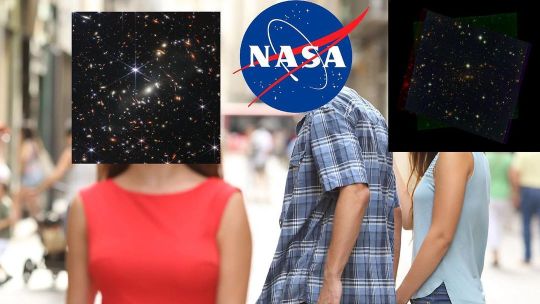
#JWST #HST #HubbleSpaceTelescope #JamesWebbSpaceTelescope #SMACS0723 https://www.instagram.com/p/Cf5Dof4Oeqn/?igshid=NGJjMDIxMWI=
1 note
·
View note
Photo
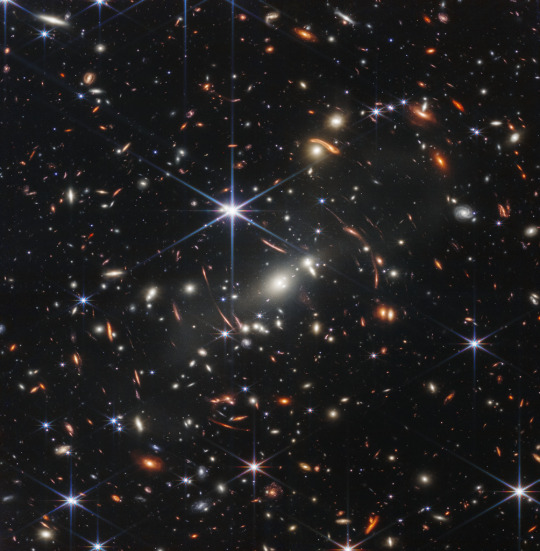
2023 July 15
Webb's First Deep Field
Image Credit: NASA, ESA, CSA, STScI, NIRCam
Explanation: This stunning infrared image was released one year ago as the James Webb Space Telescope began its exploration of the cosmos. The view of the early Universe toward the southern constellation Volans was achieved in 12.5 hours of exposure with Webb's NIRCam instrument. Of course the stars with six spikes are well within our own Milky Way. Their diffraction pattern is characteristic of Webb's 18 hexagonal mirror segments operating together as a single 6.5 meter diameter primary mirror. The thousands of galaxies flooding the field of view are members of the distant galaxy cluster SMACS0723-73, some 4.6 billion light-years away. Luminous arcs that seem to infest the deep field are even more distant galaxies though. Their images are distorted and magnified by the dark matter dominated mass of the galaxy cluster, an effect known as gravitational lensing. Analyzing light from two separate arcs below the bright spiky star, Webb's NIRISS instrument indicates the arcs are both images of the same background galaxy. And that galaxy's light took about 9.5 billion years to reach the James Webb Space Telescope.
∞ Source: apod.nasa.gov/apod/ap230715.html
81 notes
·
View notes
Photo

Webb's First Deep Field via NASA https://ift.tt/9MCWkvb
This stunning infrared image was released one year ago as the James Webb Space Telescope began its exploration of the cosmos. The view of the early Universe toward the southern constellation Volans was achieved in 12.5 hours of exposure with Webb's NIRCam instrument. Of course the stars with six spikes are well within our own Milky Way. Their diffraction pattern is characteristic of Webb's 18 hexagonal mirror segments operating together as a single 6.5 meter diameter primary mirror. The thousands of galaxies flooding the field of view are members of the distant galaxy cluster SMACS0723-73, some 4.6 billion light-years away. Luminous arcs that seem to infest the deep field are even more distant galaxies though. Their images are distorted and magnified by the dark matter dominated mass of the galaxy cluster, an effect known as gravitational lensing. Analyzing light from two separate arcs below the bright spiky star, Webb's NIRISS instrument indicates the arcs are both images of the same background galaxy. And that galaxy's light took about 9.5 billion years to reach the James Webb Space Telescope.
3 notes
·
View notes
Photo
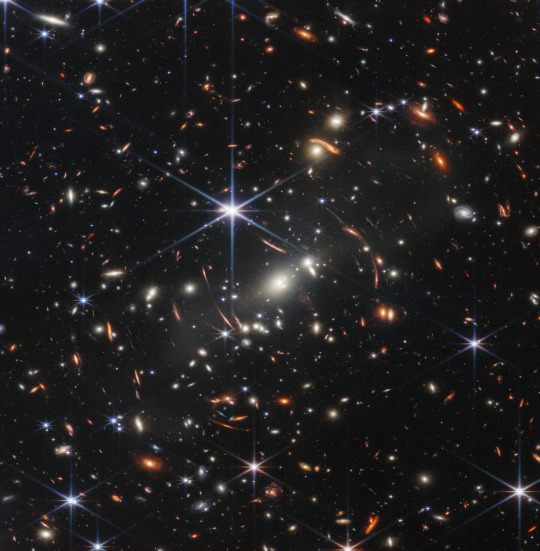
Webb's First Deep Field
This is the deepest, sharpest infrared image of the cosmos so far. The view of the early Universe toward the southern constellation Volans was achieved in 12.5 hours of exposure with the NIRCam instrument on the James Webb Space Telescope. Of course the stars with six visible spikes are well within our own Milky Way. That diffraction pattern is characteristic of Webb's 18 hexagonal mirror segments operating together as a single 6.5 meter diameter primary mirror. The thousands of galaxies flooding the field of view are members of the distant galaxy cluster SMACS0723-73, some 4.6 billion light-years away. Luminous arcs that seem to infest the deep field are even more distant galaxies though. Their images are distorted and magnified by the dark matter dominated mass of the galaxy cluster, an effect known as gravitational lensing. Analyzing light from two separate arcs below the bright spiky star, Webb's NIRISS instrument indicates the arcs are both images of the same background galaxy. And that galaxy's light took about 9.5 billion years to reach the James Webb Space Telescope.
2 notes
·
View notes
Text
Webb's First Deep Field
This stunning infrared image was released one year ago as the James Webb Space Telescope began its exploration of the cosmos. The view of the early Universe toward the southern constellation Volans was achieved in 12.5 hours of exposure with Webb's NIRCam instrument. Of course the stars with six spikes are well within our own Milky Way. Their diffraction pattern is characteristic of Webb's 18 hexagonal mirror segments operating together as a single 6.5 meter diameter primary mirror. The thousands of galaxies flooding the field of view are members of the distant galaxy cluster SMACS0723-73, some 4.6 billion light-years away. Luminous arcs that seem to infest the deep field are even more distant galaxies though. Their images are distorted and magnified by the dark matter dominated mass of the galaxy cluster, an effect known as gravitational lensing. Analyzing light from two separate arcs below the bright spiky star, Webb's NIRISS instrument indicates the arcs are both images of the same background galaxy. And that galaxy's light took about 9.5 billion years to reach the James Webb Space Telescope.
0 notes
Text
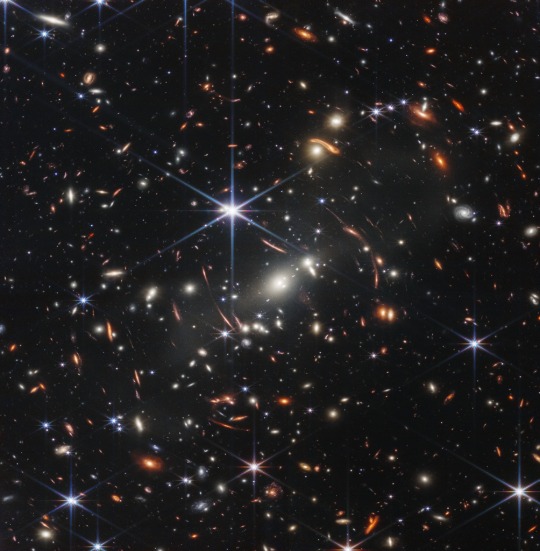
APOD: Webb's First Deep Field (7/15/23)
This stunning infrared image was released one year ago as the James Webb Space Telescope began its exploration of the cosmos. The view of the early Universe toward the southern constellation Volans was achieved in 12.5 hours of exposure with Webb's NIRCam instrument. Of course the stars with six spikes are well within our own Milky Way. Their diffraction pattern is characteristic of Webb's 18 hexagonal mirror segments operating together as a single 6.5 meter diameter primary mirror. The thousands of galaxies flooding the field of view are members of the distant galaxy cluster SMACS0723-73, some 4.6 billion light-years away. Luminous arcs that seem to infest the deep field are even more distant galaxies though. Their images are distorted and magnified by the dark matter dominated mass of the galaxy cluster, an effect known as gravitational lensing. Analyzing light from two separate arcs below the bright spiky star, Webb's NIRISS instrument indicates the arcs are both images of the same background galaxy. And that galaxy's light took about 9.5 billion years to reach the James Webb Space Telescope.
0 notes
Text

Starry Night by Vincent van Gogh
NASA: Main Image, Deep Field SMACS0723
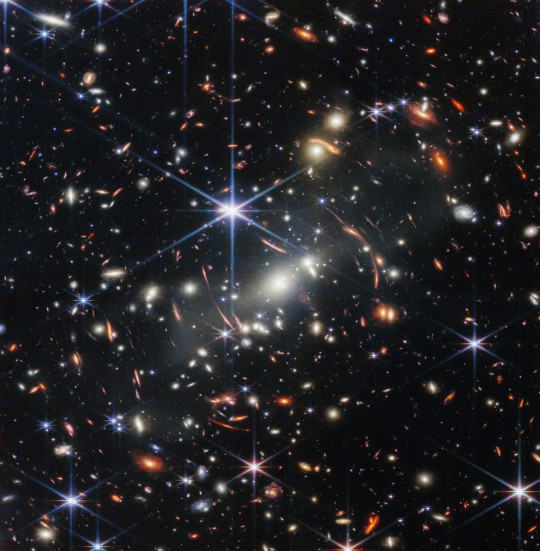
0 notes
Text
James Webb's First Deep Field image,
Re-processed by me.
https://flic.kr/p/2nzW92xhttps://astrob.in/f27wam/0/
This is the deepest, sharpest infrared image of the cosmos so far.
The view of the early Universe toward the southern constellation Volans was achieved in 12.5 hours of exposure with the NIRCam instrument on the James Webb Space Telescope.
Of course the stars with six visible spikes are well within our own Milky Way. Their diffraction pattern is characteristic of Webb's 18 hexagonal mirror segments operating together as a single 6.5 meter diameter primary mirror.
The thousands of galaxies flooding the field of view are members of the distant galaxy cluster SMACS0723-73, some 4.6 billion light-years away.
Luminous arcs that seem to infest the deep field are even more distant galaxies though.
Their images are distorted and magnified by the dark matter dominated mass of the galaxy cluster, an effect known as gravitational lensing.
Analyzing light from two separate arcs below the bright spiky star, Webb's NIRISS instrument indicates the arcs are both images of the same background galaxy.
And that galaxy's light took about 9.5 billion years to reach the James Webb Space Telescope.
Explicación de la NASA.
0 notes
Photo

Get ready to #UnfoldTheUniverse today and tomorrow, July 12 at 10:30 AM ET! ✨ Stephan’s Quintet: About 290 mil light-years away, Stephan’s Quintet is located in the constellation Pegasus. It was the first compact galaxy group ever discovered in 1787. 4 of the 5 galaxies repeated close encounters with each other due to gravity. ✨ Carina Nebula: One of the largest and brightest nebulae in the sky, is located approx. 7,600 light-years away in the constellation Carina. The Carina Nebula is home to many massive stars, several times larger than the Sun. ✨ WASP-96b: Discovered in 2014, WASP-96b is a giant exoplanet composed mainly of gas, orbiting its home-star every 3.4 days. It has about half the mass of Jupiter and is nearly 1,150 light-years from Earth. ✨ Southern Ring Nebula: The Southern Ring, or “Eight-Burst” Nebula, is a planetary nebula – an expanding cloud of gas, surrounding a dying star. It is nearly half a light-year in diameter and is located in the Vela constellation, approx. 2,000 light years away from Earth. ✨ SMACS 0723: Located in the constellation Volens, this massive galaxy cluster magnify and distort the light of objects behind them, giving us a deep field view into both the extremely distant and faint galaxy populations. SMACS stands for Southern MAssive Cluster Survey. (Credit: ESA, STSci/HST Heritage, NASA, Rice CC BY-SA 3.0 IGO) #JWST #StephansQuintet #CarinaNebula #WASP96b #SouthernRingNebula #SMACS0723 https://www.instagram.com/p/Cf37sDdO1fc/?igshid=NGJjMDIxMWI=
0 notes
Photo
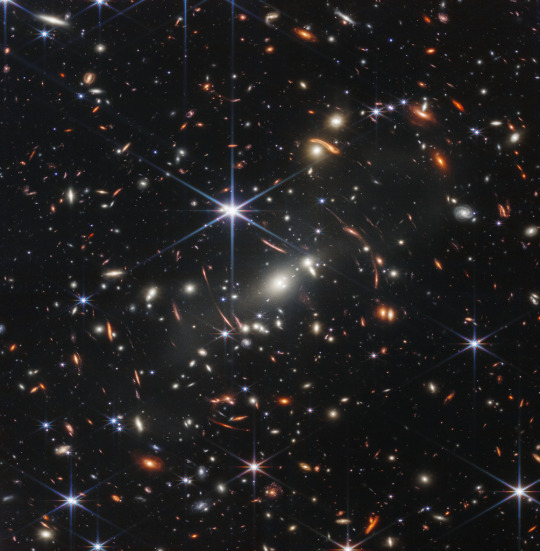
2022 July 13
Webb's First Deep Field
Image Credit: NASA, ESA, CSA, STScI, NIRCam
Explanation: This is the deepest, sharpest infrared image of the cosmos so far. The view of the early Universe toward the southern constellation Volans was achieved in 12.5 hours of exposure with the NIRCam instrument on the James Webb Space Telescope. Of course the stars with six visible spikes are well within our own Milky Way. That diffraction pattern is characteristic of Webb's 18 hexagonal mirror segments operating together as a single 6.5 meter diameter primary mirror. The thousands of galaxies flooding the field of view are members of the distant galaxy cluster SMACS0723-73, some 4.6 billion light-years away. Luminous arcs that seem to infest the deep field are even more distant galaxies though. Their images are distorted and magnified by the dark matter dominated mass of the galaxy cluster, an effect known as gravitational lensing. Analyzing light from two separate arcs below the bright spiky star, Webb's NIRISS instrument indicates the arcs are both images of the same background galaxy. And that galaxy's light took about 9.5 billion years to reach the James Webb Space Telescope.
∞ Source: apod.nasa.gov/apod/ap220713.html
64 notes
·
View notes
Photo
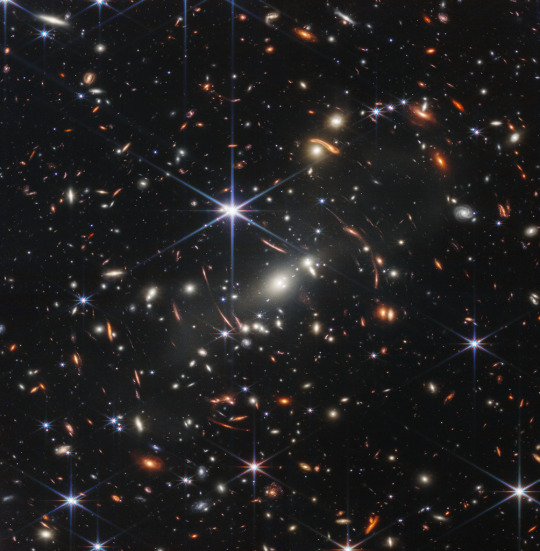
Webb s First Deep Field via NASA https://ift.tt/ZlIbhmJ
This is the deepest, sharpest infrared image of the cosmos so far. The view of the early Universe toward the southern constellation Volans was achieved in 12.5 hours of exposure with the NIRCam instrument on the James Webb Space Telescope. Of course the stars with six visible spikes are well within our own Milky Way. That diffraction pattern is characteristic of Webb's 18 hexagonal mirror segments operating together as a single 6.5 meter diameter primary mirror. The thousands of galaxies flooding the field of view are members of the distant galaxy cluster SMACS0723-73, some 4.6 billion light-years away. Luminous arcs that seem to infest the deep field are even more distant galaxies though. Their images are distorted and magnified by the dark matter dominated mass of the galaxy cluster, an effect known as gravitational lensing. Analyzing light from two separate arcs below the bright spiky star, Webb's NIRISS instrument indicates the arcs are both images of the same background galaxy. And that galaxy's light took about 9.5 billion years to reach the James Webb Space Telescope.
1 note
·
View note
Photo

Improved model for the mass distribution of galaxy cluster SMACS J0723.3−7327 based on Webb telescope image Using the first science image released by the James Webb Space Telescope (JWST) this month, an international team of scientists with significant contribution from the Technical University of Munich (TUM) has built an improved model for the mass distribution of the galaxy cluster SMACS J0723.3−7327. Acting as a so-called gravitational lens, the foreground galaxy cluster produces both multiple images of background galaxies and magnifies these images. One family of such multiple images belongs to a galaxy, which the model predicts to be at a distance of about 13 Gyrs, i.e., whose light traveled some 13 billion years before reaching the telescope. The first science image released by the James Webb Space Telescope (JWST) was of a gravitational lens, in particular the galaxy cluster SMACS J0723.3−7327. Gravitational lenses, especially galaxy clusters, magnify the light from background galaxies and produce multiple images of these. Before JWST, 19 multiple images of six background sources were known in SMACS J0723.3−7327. The JWST data now revealed 27 additional multiple images from another ten lensed sources. "In this first step towards the road opened by JWST, we used recent data from this brand new telescope, to model the lensing effect of SMACS0723 with great accuracy," points out Gabriel Bartosch Caminha, postdoc fellow at TUM, the Max Planck Institute for Astrophysics (MPA) and the German Center for Cosmological Lensing (GCCL). The collaboration first used data from the Hubble Space Telescope (HST) and Multi Unit Spectroscopic Explorer (MUSE) to build a "pre-JWST" lens model, and then refined it with newly available JWST near-infrared imaging. "The JWST imaging is absolutely astounding and beautiful, showing many more multiply lensed background sources, which allowed us to substantially refine our lens mass model," he adds. One of the most accurate models available Many of these new, lensed sources do not yet have distance estimates, and the scientists used their mass model to predict how far away these lensed galaxies are most likely to be. One of them was found to be probably at the amazing distance of 13 Gyrs (redshift > 7.5), i.e. its light was emitted during the universe's early stages. This galaxy is multiply lensed into three images and its luminosity is magnified by a factor of μ≈20 in total. However, to study these primordial objects, it is fundamental to describe accurately the lensing effect of the foreground galaxy cluster. "Our accurate mass model forms the foundation for the exploration of the JWST data," emphasizes Sherry Suyu, Professor of Observational Cosmology at TUM, Max Planck Research Group Leader at MPA and a Visiting Scholar at the Academia Sinica Institute of Astronomy and Astrophysics. "The spectacular JWST images show a great variety of strongly lensed galaxies, which can be studied in detail thanks to our accurate model." The new model for the mass distribution of the foreground cluster is capable of reproducing the positions of all multiple images with a high accuracy, making the model one of the most accurate available. For follow-up studies of these sources, the lens models, including magnification maps and redshifts (i.e., distances) estimated from the model are made publicly available. "We are very excited about this," Suyu adds. "We are eagerly awaiting future JWST observations of other strong lensing galaxy clusters. These will not only allow us to better constrain the mass distributions of galaxy clusters, but also to study high-redshift galaxies." IMAGE....In this image, the various multiply lensed background galaxies are numbered, with cyan colours indicating already known multiple image systems and green colours indicating new multiply lensed sources. The insets show enlarged images of a very distant galaxy with some substructure indicated by the green arrows. Credit: NASA, ESA, CSA and STScI (annotations by MPA)
4 notes
·
View notes
Text
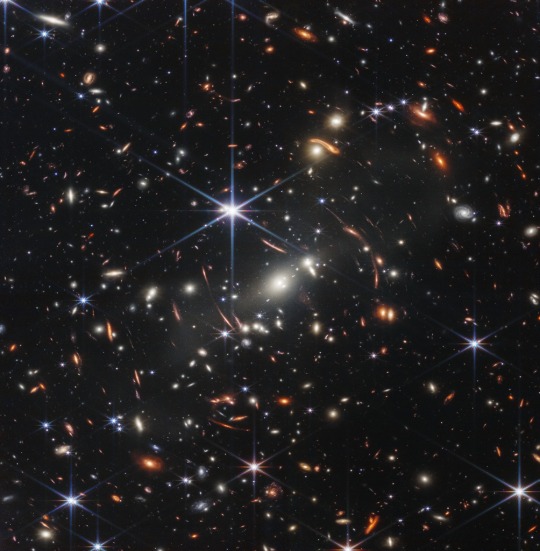
APOD: Webb's First Deep Field (7/13/22)
This is the deepest, sharpest infrared image of the cosmos so far. The view of the early Universe toward the southern constellation Volans was achieved in 12.5 hours of exposure with the NIRCam instrument on the James Webb Space Telescope. Of course the stars with six visible spikes are well within our own Milky Way. That diffraction pattern is characteristic of Webb's 18 hexagonal mirror segments operating together as a single 6.5 meter diameter primary mirror. The thousands of galaxies flooding the field of view are members of the distant galaxy cluster SMACS0723-73, some 4.6 billion light-years away. Luminous arcs that seem to infest the deep field are even more distant galaxies though. Their images are distorted and magnified by the dark matter dominated mass of the galaxy cluster, an effect known as gravitational lensing. Analyzing light from two separate arcs below the bright spiky star, Webb's NIRISS instrument indicates the arcs are both images of the same background galaxy. And that galaxy's light took about 9.5 billion years to reach the James Webb Space Telescope.
0 notes
Photo
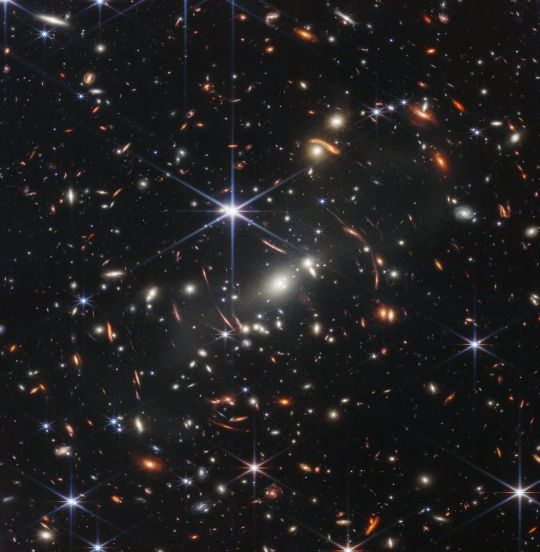
SMACS0723, 13.5 billion years into the past. If you held a grain of sand up to the sky, this is the amount of universe you’re witnessing. #JWST #UnfoldTheUniverse #NASASocial https://www.instagram.com/p/Cf44F4ZO_j7/?igshid=NGJjMDIxMWI=
0 notes
